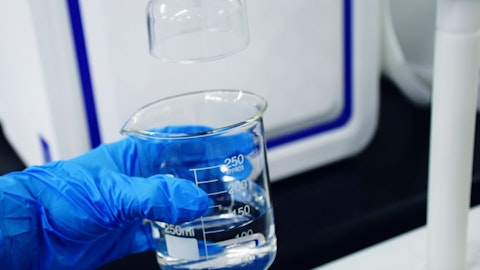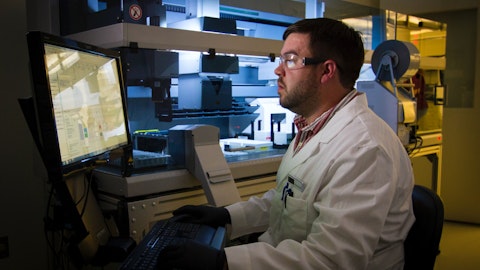Anavex Life Sciences Corp. (NASDAQ:AVXL) Q4 2023 Earnings Call Transcript November 27, 2023
Anavex Life Sciences Corp. beats earnings expectations. Reported EPS is $-0.12, expectations were $-0.16.
Operator: Good morning, and welcome to the Anavex Life Sciences Fiscal 2023 Fourth Quarter Conference Call. My name is Clint Tomlinson and I will be your host for today’s call. At this time all participants are in a listen-only mode. Later we will conduct a question-and-answer session. During this session, if you would like to ask a question, please use the Q&A box or raise your hand. Please note that this conference is being recorded and the call will be available for replay on Anevex’s website at www.anevex.com. With us today is Dr. Christopher Missling, President and Chief Executive Officer; and Sandra Boenisch, Principal Financial Officer. Before we begin, please note that during this conference call, the company will make some projections and forward-looking statements.
These statements are only predictions based on the current information and expectations and involve the number of risks and uncertainties. We encourage you to review the company’s filings with the SEC. This includes without limitation the company’s forms 10-K and 10-Q, which identify the specific factors that may cause actuary results or events to differ material from those described in these forward-looking statements. These factors may include without limitation risks inherent in the development and/or commercialization of potential products, uncertainty in the results of clinical trials or regulatory approvals, need and ability to obtain future capital, and maintenance of intellectual property rights. And with that, I’d like to turn the call over to Dr. Missling.

Christopher Missling: Thank you, Clint. And good morning, everyone. Thank you for being with us today to review our most recently reported financial results and to give our quarterly business update. We are very excited to be entering a new phase of the company’s history. For the first time, we initiated the process of submitting a marketing authorization application to the European Medicines Agency, EMA, for blarcamesine related to the treatment of Alzheimer’s disease. Relatedly, we are starting to explore possible commercial activities and examining innovative strategies to effectively engage patients, providers and payers. There is a high demand from Alzheimer’s disease patients and families for easy access and scalable treatment options.
We are striving to work towards presenting a drug that will potentially improve patients’ lives with our precision medicine oral blarcamesine, which is intended to reduce the need for complex procedures for the treatment of people with Alzheimer’s disease. According to the European Brain Council, there are an estimated 7 million people in Europe with Alzheimer’s disease, a number expected to double by 2030. Full data from the blarcamesine in Alzheimer’s disease Phase 2b/3 randomized clinical trial in Alzheimer’s disease will be published in an upcoming peer-reviewed journal. Also the respective open-label extension 96-week trial ATTENTION-AD is ongoing. Regarding Rett syndrome, we are on track for top-line data of potentially pivotal ANAVEX2-73-RS-003 Phase 2/3 EXCELLENCE pediatric clinical trial.
Regarding the Parkinson disease program, we are in preparation to initiate the ANAVEX2-73 imaging-focused trial and the ANAVEX2-73 Phase 2b/3 six months trial. Related to Schizophrenia, we are in preparation to initiate the Phase 2 clinical trial with ANAVEX3-71, our second clinical stage small molecule. With respect to Fragile X, we are in preparation to initiate a potentially pivotal ANAVEX2-73 Phase 2/3 clinical trial. And related to New Rare disease, we are in preparation to initiate a potentially pivotal ANAVEX2-73 Phase 2/3 clinical trial. We are also expecting further peer-reviewed clinical publications involving ANAVEX2-73 and ANAVEX3-71. In October, we announced a new peer-reviewed publication in the journal Neurobiology of Aging, titled, early treatment with an M1 and sigma-1 receptor agonist prevents cognitive decline in a transgenic rat model displaying Alzheimer-like amyloid pathology, featuring the orally available small molecule ANAVEX3-71.
See also 20 Most Respected Professions in the US and 25 Most Expensive Countries in the World to Raise a Child.
Q&A Session
Follow Anavex Life Sciences Corp. (NASDAQ:AVXL)
Follow Anavex Life Sciences Corp. (NASDAQ:AVXL)
This preclinical study describes the potential disease-modifying properties of ANAVEX3-71 on Alzheimer’s disease pathology as a possible drug candidate for a once daily oral preventive strategy for Alzheimer’s disease. And lastly, this month we announced the expansion and strengthening of our patent portfolio with the United States Patent and Trademark Office, USPTO, granting US patent number 11,813,242 entitled A2-73 as a therapeutic for insomnia, anxiety, and agitation. This patent expands Anavex’s existing patent coverage of blarcamesine, including U.S. Patent number 11,337,953 to cover Anavex’s leading drug candidate, blarcamesine, ANAVEX1-41 and ANAVEX19-144, for treating insomnia, anxiety or agitation. This granted US patent is another important milestone in protecting the commercial potential of blarcamesine and ANAVEX other elite compounds with a practical value of delivering holistic care for patients with Alzheimer’s disease, dementia, or Parkinson’s disease.
And now, I would like to direct the call to Sandra Boenisch, Principal Financial Officer of Anavex for a financial summary of the recently reported quarter.
Sandra Boenisch: Thank you, Christopher, and good morning, everyone. I am pleased to share with you today our fourth quarter financial results. Our cash position on September 30th was $151 million. During the quarter, we utilized cash and cash equivalents of $5.8 million to fund our operations. At our current cash utilization rate, we believe we continue to have sufficient cash runway to fund operations and clinical programs beyond the next four years. During our most recent quarter, general and administrative expenses were $2.6 million compared to $3.2 million last quarter. Our research and development expenses for the quarter were $10 million as compared to $10.3 million for the last quarter. And lastly, we reported a net loss of $10.1 million for the quarter, or $0.12 per share.
Overall, and in summary, we plan to continue to be fiscally responsible, and we believe we continue to have sufficient cash runway to fund operations and clinical programs beyond the next four years. Thank you. And now back to you, Christopher.
Christopher Missling: Thank you, Sandra. Again, this is an exciting time for the company, and we’re very excited to be entering a new phase of the company’s history with our biomarker-driven precision medicine programs. I would now like to turn the call back to Clint for Q&A.
A – Clint Tomlinson: Thank you, Christopher. We’ll now begin the Q&A session. If you have a question, please raise your hand or enter it into the Q&A box. And our first question is coming from Soumit Roy at Jones Research.
Soumit Roy: Hi, good morning, everyone. And congratulations on all the progress. First question on the EMA application. So if you can give us a little background on the discussions you’ve had with the European authority and how much data they have seen that prompted the application for full approval rather than a conditional approval?
Christopher Missling: Yes, thank you, Soumit. We have met the European Agency several times in meetings and we have shared the data which is not yet published, which is the published date of — the planned published communication of the full data of the Alzheimer Phase 2b/3 study. And we were from this meeting recommended to proceed with this application, full approval application. And that’s what we proceeded with last week accordingly.
Soumit Roy: I see. And what are the plans for the US approval? Is this going to prompt a FDA conversation if you have any meeting scheduled or you think you would go ahead with a full Phase 3 trial or 2 trials?
Christopher Missling: We have the ongoing ATTENTION-AD study ongoing and that’s part of the package of the application with the Phase 2b/3 study. We knew that the timing of the European application takes longer, so we proceeded with that first. That does not mean that we will proceed with other international applications as well. But the European decision to start the dialogue with European agency was also based on the fact that we had a majority portion of the patients in that region, so it would be a respectful decision to approach the European Agency first.
Soumit Roy: I see. And one last question on the Rett program. Could you give us a little color, when are you still expecting the data? Is it going to be before the year end 2023? And is there any delay or is it an expected safety window that you have follow-up that you have to — you are doing which is why pushing the data back.
Christopher Missling: Yes, after the last 12-week readout, there was an additional safety follow-up and that’s basically why the timing is maybe a little bit different from expectations, but we are on track to release this data once we have it.
Soumit Roy: Great. Thank you so much, and congratulations again on all the progress.
Christopher Missling: Thank you.
Clint Tomlinson: Thank you, Soumit. The next question will come from Tom Bishop at Bishop Research. Go ahead, Tom. You’re muted, I believe, Tom.
Tom Bishop: Can you hear me now?
Clint Tomlinson: Yes, there’s a little echo, but we can hear you.
Tom Bishop: Okay. Can you, will we get insomnia data?
Christopher Missling: [indiscernible] insomnia. So, part of the trial’s outcome was sleep measures of the Phase 2b/3 Alzheimer’s study and we will also have analysis of this data and we will also make sure that this data will be made public. We had noticed in our Parkinson’s disease dementia study, improvement for those patients who had insomnia to improve this indication. And we have seen similarly in the Alzheimer’s study an improvement of that endpoint as well and that also was the basis for the patent and the patent application and ultimately the granting of the patents. So the answer is yes, this data eventually will be also made public, the beneficial effect of the drug on the sleep paradigm.




